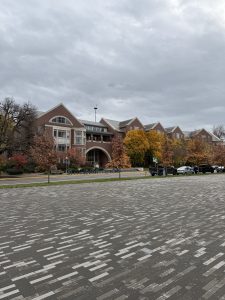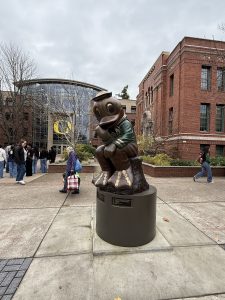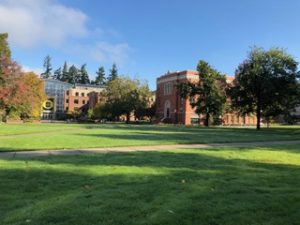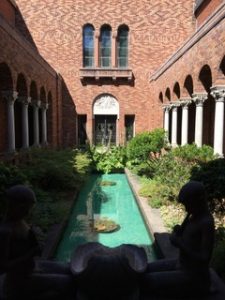Getting To Know: University of Oregon (UO)
From a virtual distance I’ve always been curious about the University of Oregon (UO).In some ways it’s a bit like the University of Delaware, not far from me.
- There’s about the same number of undergrads (approximately 20,000), an incredible mix of majors and an extremely high–most recently 88 percent–acceptance rate.
- Both schools are a major draw for non-residents. UO gets nearly half of a freshman class from other states; for UDel its 70 percent.
- Each school has a well developed honors college.. They have about the same number of students, approximately 1,400 at UO and approximately 1,500 at UDel.
- UO and UDel have iconic mascots. No other school has a Duck (UO) or a Blue Hen (UDel) as they mascot.
Yet while UO has produced considerable talent for the NFL, UDel has had two alumni quarterbacks lead teams to the Super Bowl, UO has none though maybe Justin Herbert can do it before his career wraps up! UDel is also less than an hour and a half from either Baltimore or Philadelphia. UO is two hours from Portland.
UO also reminded me of my visits to the University of New Hampshire (UNH) and the University of Vermont (UVM).
- These schools are located in college towns, have campuses with interesting architecture and lush green spaces, and have easy access to an ambundence of outdoor recreational activities.
- Health, fitness and nature drive community life in Durham (NH) and Burlington (VT).
But UO is a larger school that kicks these up to a higher level and a higher sports profile!
There’s a good College Tour program on UO. But now, I’d like to ask you to read on!
Here’s a few of the academic things that I like about the University of Oregon.
- The Clark Honors College has admission by application versus admission by invitation. You can apply, even if your academic profile is not likely to be at or near the top of the freshman class. There’s only one supplemental essay, so it’s worth taking a shot if your target program is here. The downside: Clark Honors students are asked to pay slightly more in tuition than other UO students to help cover programming costs.
- There are majors that are tough to find elsewhere such as Advertising, Art & Technology, Cybersecurity, Environmental Design Music Composition, Product Design and Scandinavian. There are also many timely and interesting minors.
- There are fewer hassles with internal transfers between schools than you might find at more selective public and private universities. About a quarter of incoming freshmen enter UO undecided on a major and choose Exploring as their major when they apply.
- Generous scholarships are available for the strongest applicants. The Stamps Scholarship Program is a rare but true “full ride,” covering all costs, including a research stipend, but excluding transportation to and from hime. Twenty resident and twenty non-resident Stamps Scholars are selected each cycle.
Now, here’s a few non-academic things I really like
- The campus. Quite honestly, this is one of the nicest campuses I have ever seen at a state university. It’s a very nice blend of old and new, less intimidating than other large schools I’ve visited or taken virtual tours. Biking, hiking and running trails feel like they are an extension of the campus as well as the local community. I’d like to thank my colleagues Beverly Brutzkus and Elaine Powrie for sharing these with me. I’ve dropped three campus photos from Elaine below. Beverly gave me the last two as well as the one you see up top.
s


- The community. Eugene is a true college town, though it might be more isolated than some prospective students would like. It’s about two hours from either Portland or the Oregon Coast. But it doesn’t feel as crowded as places like State College, Pennsylvania. With a population of nearly 180,000, including students, Eugene has more residents than Ann Arbor , East Lansing or State College, all Big Ten cities that host much larger state universities.
- School spirit. UO is known for having excellent football but Eugene, home to the university since 1876 is known as Track Town USA .The university’s Hayward Field was host to the 1972, 1976, 1980 and 2000 US Olympic trials. Bill Bowerman, who coached the Ducks from 1948 to 1973, is famous not only for a successful track program; he also designed the original “waffle sole” for Nike shoes and maintained an innovation lab where he developed new ideas for track apparel to present to Nike. One of his former runners, Phil Knight, founded Nike, and he is still one of the leading financial supporters of the university.
- A model sports program. This past year, UO ranked second only to Penn State among Big Ten schools in the national Director’s Cup standings and seventh among all D-1 schools in the nation. The Director’s Cup is a rating of the entire athletic program versus a single sport.
- The Duck. You must listen to this history of how the mascot, unofficially called ‘Puddles’ evolved. There are many college teams called Bears, Bulldogs, Cougars, Eagles and Tigers. But there’s only one Duck. Elaine Powrie shared three Duck tributes that I posted below.



- Sixty percent of 2024 graduates graduated with no student loan debt. The average indebtedness of those who borrowed was just over $28,000. The maximum that graduates could have borrowed over four years was $27,000.
- There are over 27,000 UO alumni living in California registered on LinkedIn.com. If you want to live in Oregon or California the networks are substantial.
Here’s some possible downsides.
- UO locks in the freshman tuition charges over four years, but the residential cost of attendance is fairly high for a state university. The non-resident estimate is also high, nearly $69,000. About 30 percent of the 2024 freshman class received merit-based scholarships, but they averaged a relatively low $6,600. The average needed-based award was just over $12,000.
- UO can house less than 30 percent of the undergraduate student body. Rentals close to campus can get pricy. Greek life is somewhat important at UO, attracting nearly a fifth of the undergraduates.
- UO is not part of the Western Undergraduate Exchange (WUE), a multi-state collaboration where non-resident students pay discounted tuition if they come from one of its member states. If you’re a Californian and you want the discounted tuition at a flagship in Oregon, you have to apply to Oregon State,
- The same point is true if you want to become an engineer. You have to apply to Oregon State. The only engineering program at UO is a Bioengineering minor.
- If you want a school that’s close to major city look elsewhere. It’s a two-hour drive to Portland. Eugene is the second-largest city in Oregon and has plenty for college students to do. But it’s not like living in Seattle and going to U-Dub.
- Those whose politics lean towards the right might not like UO. As one example, the recent ‘No Kings’ rally in Eugene attracted over 4,000 protesters. That’s a lot for a city of 180,000 people, especially since the university has half the undergraduate population of a school like Michigan State, Ohio State or Penn State.
- Retention and graduation rates could be better. UO’s freshman retention rate of 86 percent is similar to the University of New Hampshire. Eleven years ago, UO graduated less than half of their freshman classes. The four-year grad rate has surpassed 60 percent beginning with the Class of 2019. That’s lower than any University of California campus excluding UC Merced. It’s also lower than the outdoorsy universities that I have visited, UMass-Amherst, UNH and UVM.
Conclusions
From a distance UO looks and feels like it would be my second-favorite West Coast university, after Stanford. I love the campus setting and school spirit. It’s a great option for Californians who do not get into their first-choice schools in state. But the costs need to work out.
The Report Card: University of Oregon (UO)
- Four-Year/Six-Year Graduation Rates: B/B
- Freshman Retention: B+
- Costs:B
- Comforts: B
- Community: A
- Curriculum: A
- Connections: A (California and Oregont)/C (elsewhere)
Buy my new book, The Good College!
Listen to my latest interview on ‘Tests and the Rest’ with Amy Seeley and Mike Bergin!
Check out my talk, What Exactly Is a Good College? hosted by test-prep experts Amy Seeley and Mike Bergin on Tests And The Rest!
Sharing is caring!



